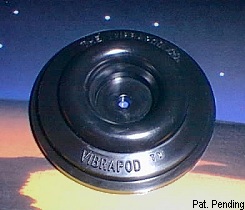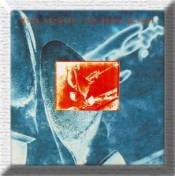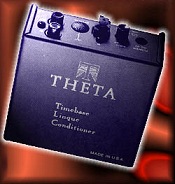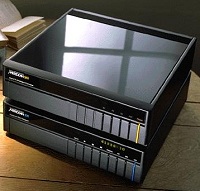Attack of the Pods
from Planet Kennard!
 Call me
anything including late for dinner, but donít call me a tweak.
Iím no tweak. For the most part, I donít even want to hear about your
favorite tweak! And I sure donít want a steady diet of reading about
them in my favorite magazines! Oh, how some can go on and on about
contact cleaners is just beyond me. How anybody can go on for
pages and pages about the sound of a piece of wire astounds me! I donít
know whether to send them a congratulatory letter on their hearing acuity or
just suggest that they take their medicine!
Call me
anything including late for dinner, but donít call me a tweak.
Iím no tweak. For the most part, I donít even want to hear about your
favorite tweak! And I sure donít want a steady diet of reading about
them in my favorite magazines! Oh, how some can go on and on about
contact cleaners is just beyond me. How anybody can go on for
pages and pages about the sound of a piece of wire astounds me! I donít
know whether to send them a congratulatory letter on their hearing acuity or
just suggest that they take their medicine!
Oh, Iíve
tried a few, Iíve done the "cones" thing, Iíve tried the contact cleaner
thing, Iíve done the sorbothane pucks thing and Iíve tried the cable thing,
all largely to no avail. Donít misunderstand, Iím not saying that none
of these have an effect (though most donít), Iím saying that pouring money
into them returns you little bang for the buck and even when something does
effect a change, who is to say whether itís a good one or a bad one? All
one really knows is that itís "different".
So when Sam
Kennard of "The Vibrapod Company" E-mailed me that he wanted me to try
something, I politely agreed. Why be rude! Iíll give what ever he
is talking about a try and politely apologize for not hearing any difference
in my system ("I guess my system is just immune to your tweek.
Sorry!"). Promptly, I received a package of what Mr. Kennard calls
"Vibrapodô Isolation Pods". Oh, goody. Vibrapods are a new
isolation device designed to isolate components from mechanical vibrations
transmitted through equipment via the shelf/stand it rests upon.
Now, Iíll be
very open and up front about the fact that Sam Kennard is a friend of
mine. But I swear to you that this has absolutely no bearing on what you
are about to read. If a friend of mine thinks heís on to something, and
I think heís nuts or is about to make a fool of himself, I think it would be
my duty, as a friend, to tell him so. I would rather be a friend than a
facilitator. Although I have been sent "tweeky" things in the past, Iíve
never heard the claimed benefits and Iíve been up front and told the sender as
much. In the back of my mind also is the possibility that these people
know exactly what it is they are sending me and if I pretend to hear
it, just to appease them, then Iíll just be squandering what ever respect or
credibility I have. No way Josť.
Back to my
story.
So, several
days went by and I got a couple E-mails from Sam asking had I tried them
yet! He really wanted my opinion! As convincingly as I could, I
explained to Sam that I was indeed going to, but had not yet had the
opportunity. Truth is, I guess, I could have, had I really been
interested. But I gave him a promise that by next Tuesday, I would
indeed give them a shot.
 So, on Tuesday morning, I grudgingly and half heatedly set off to fulfill my
obligation to my friend. I went to my upstairs listening room, armed
with 24 of these black vinyl donut looking "thingies" and I looked at my
system. Of all the components, under which would I try these
"Vibrapods" on first? Which of them would most benefit? I settled
on my Conrad Johnson PV12a pre-amp. As a tube pre-amp, I figured that it
could do with some additional immunity to vibration. So, I removed the
preamp from its shelf, I placed 4 rows of 3 each of these pods on the shelf,
placed a glass shelf on top of the pods and placed the CJ on the glass
shelf. I then hit the Ďplayí button and began playing a CD that is a
favorite of mine, Dire Straitsí "One Every Street". Track #6, "You and
Your Friend" in particular. Its opening sequence of steel guitar and
cymbals is an excellent test of sound stage width. I had been listening
to this track because as I had just installed a new speaker pair into my
system, I used this track to judge that the speakers were too close together
because I was not getting the sound stage width I was used to. With preceding
pairs of speakers, the width of the sound stage had been much
wider. But as my mission on this day was not to fiddle with speaker placement,
I didnít bother moving anything.
So, on Tuesday morning, I grudgingly and half heatedly set off to fulfill my
obligation to my friend. I went to my upstairs listening room, armed
with 24 of these black vinyl donut looking "thingies" and I looked at my
system. Of all the components, under which would I try these
"Vibrapods" on first? Which of them would most benefit? I settled
on my Conrad Johnson PV12a pre-amp. As a tube pre-amp, I figured that it
could do with some additional immunity to vibration. So, I removed the
preamp from its shelf, I placed 4 rows of 3 each of these pods on the shelf,
placed a glass shelf on top of the pods and placed the CJ on the glass
shelf. I then hit the Ďplayí button and began playing a CD that is a
favorite of mine, Dire Straitsí "One Every Street". Track #6, "You and
Your Friend" in particular. Its opening sequence of steel guitar and
cymbals is an excellent test of sound stage width. I had been listening
to this track because as I had just installed a new speaker pair into my
system, I used this track to judge that the speakers were too close together
because I was not getting the sound stage width I was used to. With preceding
pairs of speakers, the width of the sound stage had been much
wider. But as my mission on this day was not to fiddle with speaker placement,
I didnít bother moving anything.
I hit the
play and #6 buttons on the remote and settled down for a little listening.
NO
WAY!! I must be hearing things!! The Sound stage was now as
wide as I have ever heard it! And, where did all that bass come
from?? The bass had become positively visceral! In total
disbelief, I jumped up, picked up the preamp, swept off the pods and replaced
the preamp to where it had started its day.
Play...
#6,Öcollapsed sound stage again. Bass?? Not bad, but not like it
was.
So up again
I jumped, replaced the Vibrapods, the glass shelf, the PV12a,
play...#6....ahhhhhhh. There it was again. Soundstage was wide,
deep and precise in its placement of instruments. Bass was clean and
more articulate than before.
It was
obvious that this was not going to be another wild tweak chase!
 So.... What next to isolate? How
Ďbout...my CD changer?? I use a Yamaha CD changer as a transport (I told you Iím no tweak!)
and run it into a Theta TLC and then into a Meridian 563 DAC.
This, I thought, would be a tough test. I mean, isolating tubes,
I can kinda see, but isolating the CD changer? Yeah, right!
So, I followed the same procedure as above. Placed 3 rows of 4 pods,
placed another shelf on the pods, and placed the Yamaha on top of that.
Put back on the same song.
So.... What next to isolate? How
Ďbout...my CD changer?? I use a Yamaha CD changer as a transport (I told you Iím no tweak!)
and run it into a Theta TLC and then into a Meridian 563 DAC.
This, I thought, would be a tough test. I mean, isolating tubes,
I can kinda see, but isolating the CD changer? Yeah, right!
So, I followed the same procedure as above. Placed 3 rows of 4 pods,
placed another shelf on the pods, and placed the Yamaha on top of that.
Put back on the same song.
Unbelievable. Im serious! I couldnít believe it! The sound
stage was wider still! The opening guitar riff was coming out of the CD
player that is to the left of the speaker! Bass, again, was even more
visceral! It was downright physical! But there was something else
too! (Is anybody else hearing the ĎTwilight Zoneí theme music???)
The "canvas" upon which the system was painting the image was actually
"blacker" than it was before. Out of this new black abyss the
instrumental outlines were sharper and more vivid than what I had been
hearing. Sam later told me that some report a drastic cleansing of the
treble too, sometimes to the point of cleaning up and reducing sibilants, but
I didnít experience that as far as I could tell. But after what I did
experience, I wouldnít doubt it.
Mind control
drugs! That must be what is at work here! The Vibrapod
Company has found a way to polymerize some kind of mind control drug, infuse
it into the vinyl pods in a way that will allow it to slowly evaporate into
the air in a time release fashion thereby introducing said drug into the
listener as he breathes! Naaaa... as I said, Sam is a friend of mine,
and while heís a nice guy, heís not that smart!
Instead what
Sam has come up with is a vinyl ring that when placed in numbers (numbers
required vary according to weight of the component) under your rig, will do an
outstanding job of isolating it from the vibration transmitted from your
speakers, through the floor, into the rack and, finally, into the
components. This Vibrapod is a black vinyl ring with a second concentric
ring within it, looking very much like the suspension for a dynamic speaker
driver. The "ring" sits on the shelf and this inner ring, which is
raised in level compared to the outer one, is what supports the component and
it really does so in the exact same way the speaker suspension supports the
woofer, itís there that you get the suspension compliance.
Unfortunately, I was now out of Vibrapods. At this point, Iíll just have
to wait until Sam sets up his distribution system, which will be in place on
June 15, 1998. Sam is selling them factory direct for the extremely
reasonable price of $6 each delivered in the Continental US. Each
Vibrapod can support between 2Ĺ and 4 pounds, 2 5/8 pounds being ideal.
The average CD player will require 6 Vibrapods and cost you $36. Given
the prices of numerous snake oil remedies readily available, which accomplish
nothing, more than a drain on your bank account, $6 each is a real
steal. Oh, wanna know the best part? The Vibrapod Company is going
to donate 10% of sales (that's sales, not profit!) to Outreach
Organizations. So, do something for your system as well as for charity
and give Sam a call. You wonít regret it.
This doesnít
make me a tweak, ... does it??
Good luck and listening,
© John R. Potis Jr. 1998.
JPotis@compuserve.com
Follow up
 In the weeks since I wrote the preceding
review, Iíve had the opportunity to receive more "Vibrapods" and have had the
opportunity to experiment with placements.
In the weeks since I wrote the preceding
review, Iíve had the opportunity to receive more "Vibrapods" and have had the
opportunity to experiment with placements.
The
improvement was so real and so positive that I went out and purchased several
sheets of ľ inch glass with which to better implement the pods. I had
them cut to 13 inches by 16 inches, which guaranteed that each would fit under
the feet of any component in the house. I now placed the pods on the
shelves, placed the glass sheets upon the pods and then set the component on
the glass sheet. It works wonderfully and actually looks nice
too!
Iíve also
been playing around with the configuration of the Vibrapods under that
glass. Sam Kennard tells me that he has experienced better success with
the Pods placed around the outside edges of the component. To be honest,
Iíve been shuffling components and speakers from room to room and have
temporarily lost my "reference point". I can tell you that in what ever
configuration I use, the difference is large and definite and always for the
better.
Iíve also
been loaning these things to friends. With no prompting from me, they
always come back ecstatic about what they find. People with distinctly
"mid-fi" systems are every bit as likely to benefit from the Vibrapods as
people with much more expensive components. It makes sense when you
think about it, more budget priced components would likely have
had less vibration isolation consideration during the design stage.
Owners of budget gear should, in my opinion, consider them as a "no-brainer"
treatment that can be utilized as components are upgraded.
As I sit
here typing, Iím spinning vinyl. My "B-team" turntable is a Technics
SL1500 MKII with a Sumiko Blue Point installed. Of course, it has
Vibrapods installed underneath. Well, I just noticed that I can
really crank the music with no feedback, something I couldnít do in
this smallish room before. Call me stupid, but in this, the age of CD, I
hadnít, until now, even considered what using it under a turntable can
do. You vinyl spinners out there should take special note. You
wonít believe what this inexpensive tweek can do for your records!
Forget about the ridiculously expensive air isolation devices until you give
these a shot.
For
increased dynamics, better soundstage focus, depth and width, more physical
and articulate bass, and maybe even a smoother treble, these Vibrapod
Isolation Pods are enthusiastically, nay, emphatically
recommended!
Good luck and listening,
© John R. Potis Jr. 1998.
JPotis@compuserve.com


 Call me
anything including late for dinner, but donít call me a tweak.
Iím no tweak. For the most part, I donít even want to hear about your
favorite tweak! And I sure donít want a steady diet of reading about
them in my favorite magazines! Oh, how some can go on and on about
contact cleaners is just beyond me. How anybody can go on for
pages and pages about the sound of a piece of wire astounds me! I donít
know whether to send them a congratulatory letter on their hearing acuity or
just suggest that they take their medicine!
Call me
anything including late for dinner, but donít call me a tweak.
Iím no tweak. For the most part, I donít even want to hear about your
favorite tweak! And I sure donít want a steady diet of reading about
them in my favorite magazines! Oh, how some can go on and on about
contact cleaners is just beyond me. How anybody can go on for
pages and pages about the sound of a piece of wire astounds me! I donít
know whether to send them a congratulatory letter on their hearing acuity or
just suggest that they take their medicine! So, on Tuesday morning, I grudgingly and half heatedly set off to fulfill my
obligation to my friend. I went to my upstairs listening room, armed
with 24 of these black vinyl donut looking "thingies" and I looked at my
system. Of all the components, under which would I try these
"Vibrapods" on first? Which of them would most benefit? I settled
on my Conrad Johnson PV12a pre-amp. As a tube pre-amp, I figured that it
could do with some additional immunity to vibration. So, I removed the
preamp from its shelf, I placed 4 rows of 3 each of these pods on the shelf,
placed a glass shelf on top of the pods and placed the CJ on the glass
shelf. I then hit the Ďplayí button and began playing a CD that is a
favorite of mine, Dire Straitsí "One Every Street". Track #6, "You and
Your Friend" in particular. Its opening sequence of steel guitar and
cymbals is an excellent test of sound stage width. I had been listening
to this track because as I had just installed a new speaker pair into my
system, I used this track to judge that the speakers were too close together
because I was not getting the sound stage width I was used to. With preceding
pairs of speakers, the width of the sound stage had been much
wider. But as my mission on this day was not to fiddle with speaker placement,
I didnít bother moving anything.
So, on Tuesday morning, I grudgingly and half heatedly set off to fulfill my
obligation to my friend. I went to my upstairs listening room, armed
with 24 of these black vinyl donut looking "thingies" and I looked at my
system. Of all the components, under which would I try these
"Vibrapods" on first? Which of them would most benefit? I settled
on my Conrad Johnson PV12a pre-amp. As a tube pre-amp, I figured that it
could do with some additional immunity to vibration. So, I removed the
preamp from its shelf, I placed 4 rows of 3 each of these pods on the shelf,
placed a glass shelf on top of the pods and placed the CJ on the glass
shelf. I then hit the Ďplayí button and began playing a CD that is a
favorite of mine, Dire Straitsí "One Every Street". Track #6, "You and
Your Friend" in particular. Its opening sequence of steel guitar and
cymbals is an excellent test of sound stage width. I had been listening
to this track because as I had just installed a new speaker pair into my
system, I used this track to judge that the speakers were too close together
because I was not getting the sound stage width I was used to. With preceding
pairs of speakers, the width of the sound stage had been much
wider. But as my mission on this day was not to fiddle with speaker placement,
I didnít bother moving anything. So.... What next to isolate? How
Ďbout...my CD changer?? I use a
So.... What next to isolate? How
Ďbout...my CD changer?? I use a  In the weeks since I wrote the preceding
review, Iíve had the opportunity to receive more "Vibrapods" and have had the
opportunity to experiment with placements.
In the weeks since I wrote the preceding
review, Iíve had the opportunity to receive more "Vibrapods" and have had the
opportunity to experiment with placements.